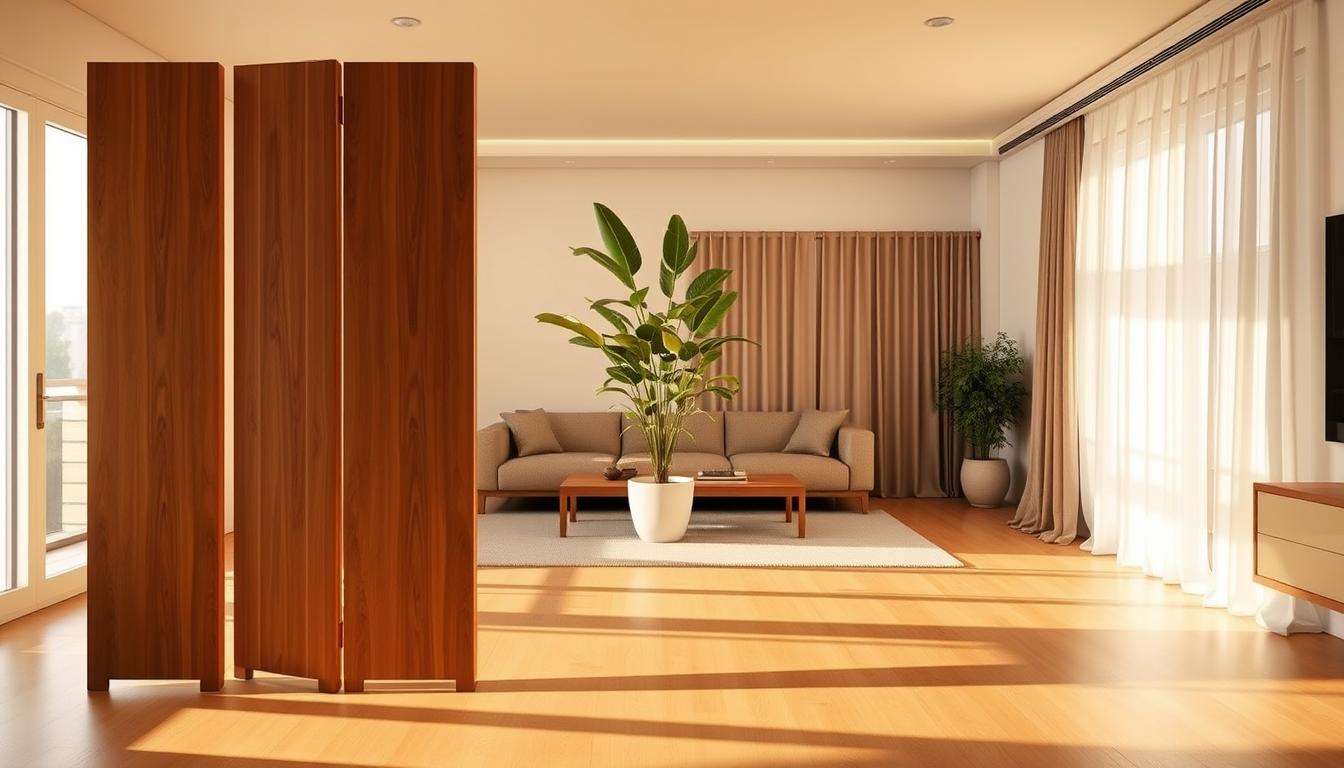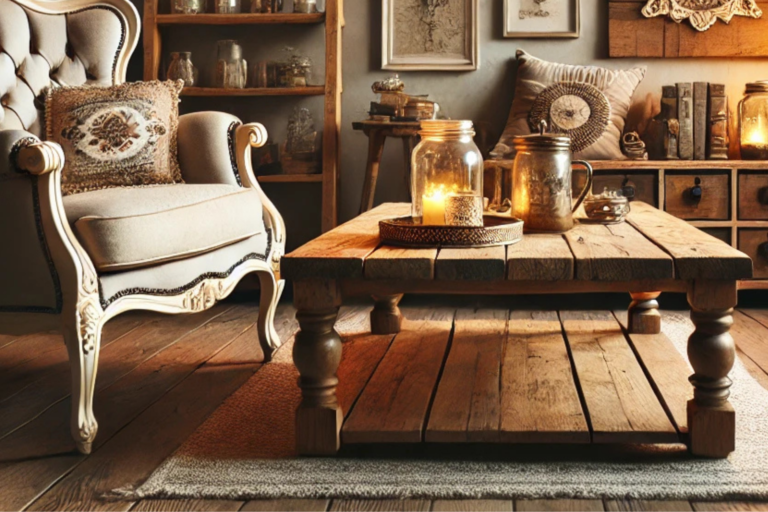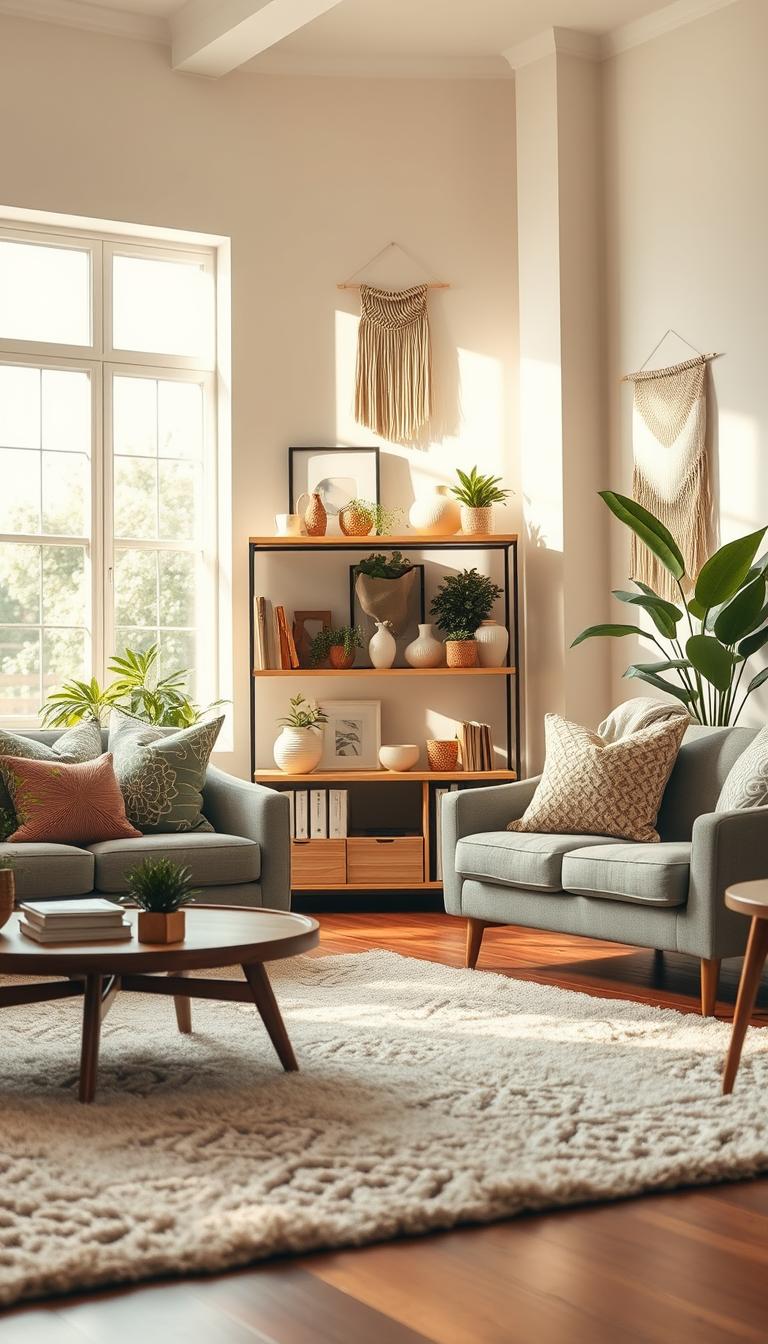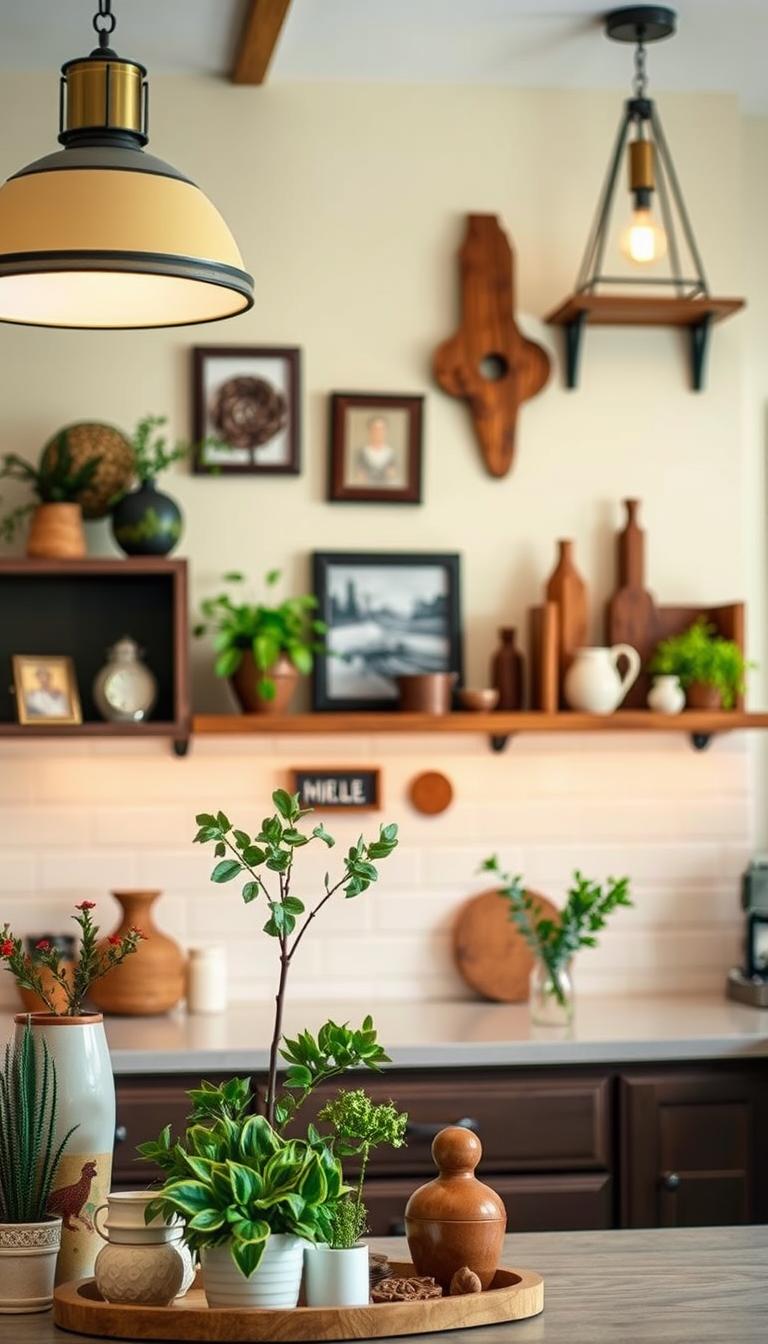Did you know that nearly 70% of UK homeowners feel their open-plan spaces lack definition? While modern interiors prioritise light and flow, many crave subtle ways to create cosy zones without sacrificing that airy appeal. This is where inventive room dividers step in – blending practicality with aesthetic charm.
This post contains affiliate links. If you purchase through these links, I may earn a small commission at no extra cost to you. Learn more here.
Non-permanent solutions, from lush indoor plant screens to cleverly positioned shelving units, offer flexibility for evolving needs. They preserve natural illumination while gently guiding movement through your space. Imagine a living wall of trailing ivy softening the edge between lounging and dining areas, or a sleek modular unit doubling as storage and visual separation.
Modern life demands adaptability. Your living room might host remote work by day and family relaxation by evening. Temporary dividers respect this rhythm, allowing you to reconfigure zones as required. Even simple choices like contrasting rugs or strategic lighting can establish boundaries without heaviness.
Key Takeaways
- Non-permanent dividers maintain an open-plan feel while adding functional zones
- Natural light preservation remains central to successful room separation
- Furniture arrangements can serve dual purposes as storage and spatial guides
- Botanical elements introduce organic texture whilst softening transitions
- DIY solutions allow personalisation to match existing décor styles
Benefits of Dividing Your Living Room Without a Wall
Creating distinct areas in your home needn’t involve dusty renovations or permanent fixtures. Modern approaches to spatial design cleverly balance practicality with aesthetics, offering quick, easy solutions that adapt to your lifestyle. These methods preserve your room’s natural flow while introducing subtle structure where it matters most.
Enhancing Functionality and Privacy
Non-permanent dividers excel at carving out private corners without isolation. A freestanding screen beside your sofa creates an instant home office nook, while sheer curtains around a reading chair maintain visual connection to the wider space. Studies show that such flexible room division ideas reduce noise distractions by up to 40%, making them ideal for households juggling multiple activities.
Maintaining a Light and Airy Ambience
Unlike solid walls, open dividers play with light rather than blocking it. Glass-panelled units or ladder shelves allow sunlight to dance through your living area while defining zones. This approach works particularly well in British homes, where maximising natural illumination remains crucial during shorter daylight months.
The beauty lies in the balance – you gain purposeful areas without compromising that cherished sense of openness. As one interior designer notes: “Smart dividers act like punctuation marks in a sentence, giving rhythm to your space without interrupting its story.”
Creative Room Divider Solutions Using Furniture
Your existing furnishings hold untapped potential for shaping spaces. With thoughtful placement, everyday pieces like bookshelves or display units can transform into elegant room dividers that honour your home’s architectural flow. The trick lies in selecting items that feel intentional rather than obstructive.
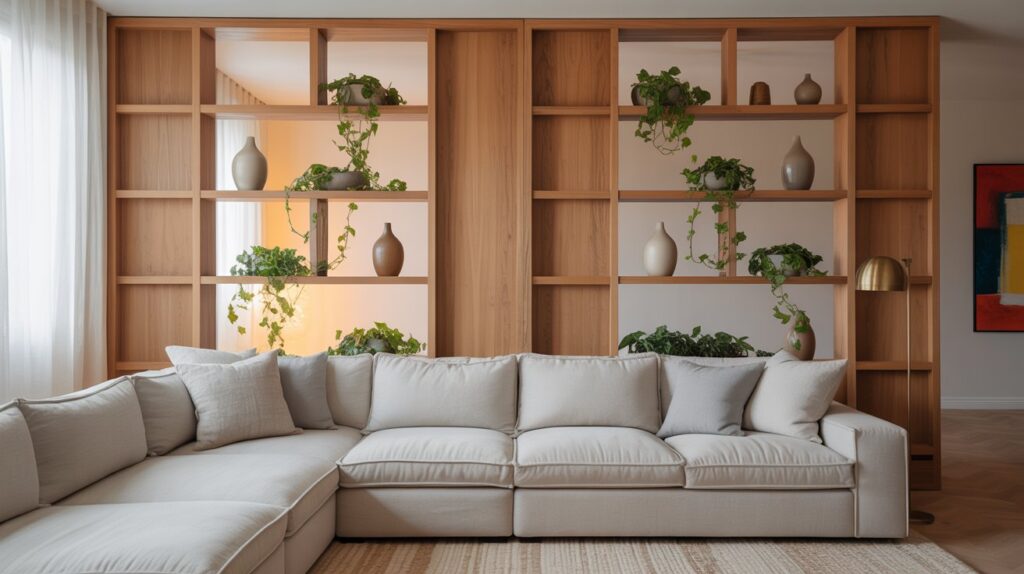
Consider an etagere bookcase – its open framework creates visual separation while maintaining light penetration. Interior stylists often recommend Habitat’s modular designs or IKEA’s IVAR system for their adaptable proportions. Style shelves with a mix of books, trailing plants and ceramics to blur the line between functional divider and curated display.
Open Shelving and Etagere Bookcases
These airy storage solutions excel at defining zones without heaviness. Position a double-sided unit between seating and dining areas to subtly guide movement. For smaller spaces, slimline ladder shelves from brands like Dunelm offer proportional scaling.
Keep finishes consistent with your existing décor – a walnut-stained oak unit harmonises beautifully in heritage homes, while powder-coated steel suits industrial schemes. As designer Naomi Astley Clarke observes: “Furniture-based dividers work best when they feel like natural extensions of your interior narrative.”
Beyond aesthetics, these pieces solve practical challenges. Use lower shelves for baskets of blankets or board games, reserving upper tiers for decorative touches. This approach maintains sightlines across rooms while softly signalling separate functions – ideal for households craving flexible layouts.
Inspiring Ideas from a Living Wall of Plants
Nature’s embrace transforms living spaces in ways bricks never could. Vertical gardens and cascading foliage screens bring organic structure to open-plan layouts, creating gentle transitions between areas. These living boundaries appeal particularly to urban dwellers seeking biophilic design elements that counterbalance concrete landscapes.
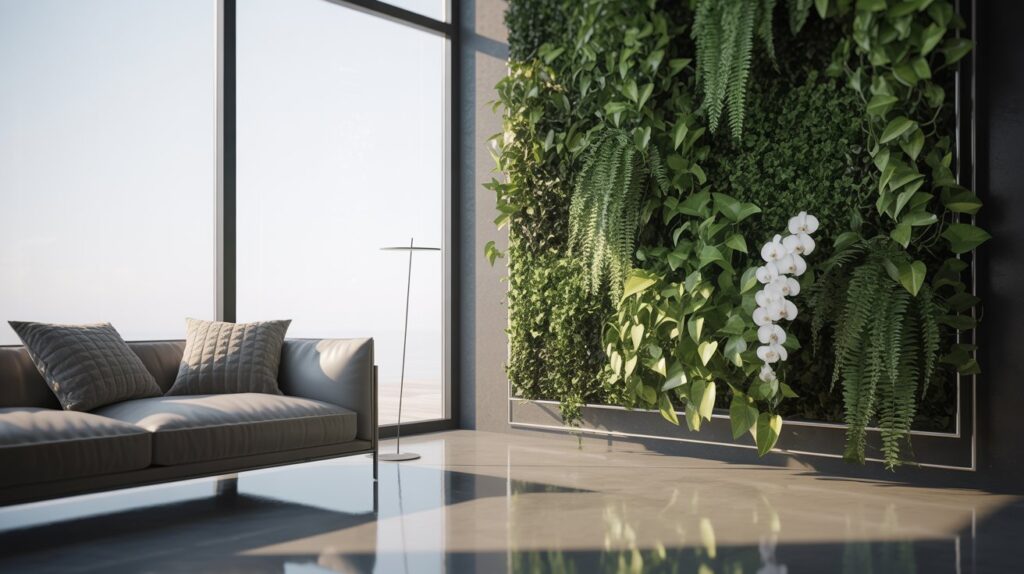
Using Greenery to Create Natural Boundaries
A well-curated wall of plants serves dual purposes – it defines zones while purifying air through natural filtration. Design houses like The Biophilic Studio recommend spider plants and devil’s ivy for their low maintenance and trailing habits. These species form lush curtains that soften edges between lounge and dining spaces without blocking light.
Compared to traditional room dividers, living walls offer surprising cost efficiencies. Initial setup for a 1.5m x 1m modular system starts around £180, while quality screens often exceed £300. Maintenance involves weekly watering and seasonal pruning – a therapeutic ritual many find preferable to dusting flat surfaces.
For those seeking inspiration, living wall ideas showcase creative arrangements using reclaimed pallets or geometric planters. Position taller specimens like fiddle-leaf figs near seating areas to enhance privacy, while air plants in hanging terrariums maintain visual connectivity above eye level.
As landscape designer Flora Hartley observes: “Plants don’t just divide spaces – they weave them together through movement and growth.” This dynamic quality makes botanical solutions ideal for evolving households wanting both definition and fluidity in their interiors.
The Magic of Freestanding Screens
Few design elements combine practicality with theatrical flair quite like freestanding screens. These versatile dividers act as spatial chameleons – one moment defining a cosy reading nook, the next concealing clutter before guests arrive. Their charm lies in instant transformation without commitment, making them ideal for renters or serial redecorators.
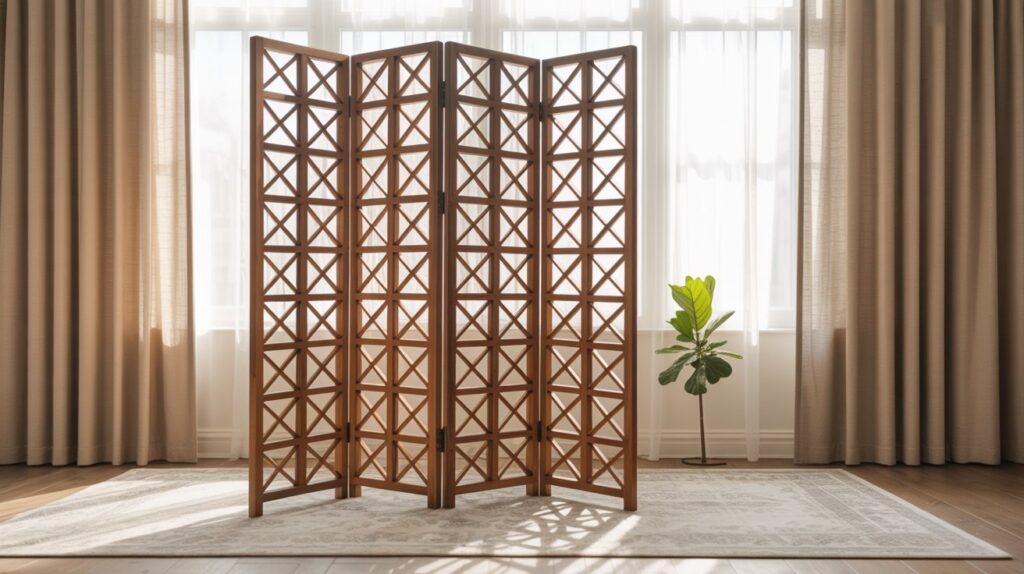
Consider a Japanese-inspired rice paper screen softening the boundary between lounge and study areas. Its translucent panels maintain light diffusion while creating psychological separation. Meanwhile, laser-cut metal designs from retailers like John Lewis or Made.com cast intricate shadows, adding decorative interest alongside spatial definition.
The true magic emerges in their adaptability. A four-panel folding screen can shrink or expand your zones daily – fully extended for evening privacy, neatly folded against a wall by morning. This fluidity respects open-plan principles while accommodating evolving needs, from temporary workstations to play areas.
Quality designs prioritise both form and function. Urban Outfitters’ rattan screens bring organic texture to minimalist spaces, while West Elm’s modular panels allow custom configurations. As interior stylist Lorna Haigh notes: “A well-chosen screen doesn’t just divide a room – it becomes part of its visual poetry.”
Imagine pivoting a three-panel screen to redirect foot traffic during gatherings, or using a vintage find to disguise unsightly radiators. These moments epitomise the screen’s unique talent – balancing discretion with statement-making potential in equal measure.
Implementing a Semi-Structural Room Divider
Semi-structural dividers bridge the gap between temporary screens and built walls. These customisable partitions offer reassuring solidity without the permanence of brickwork, ideal for homeowners seeking adaptable solutions. Unlike flimsy screens, they provide defined spatial separation while maintaining your room’s architectural integrity.
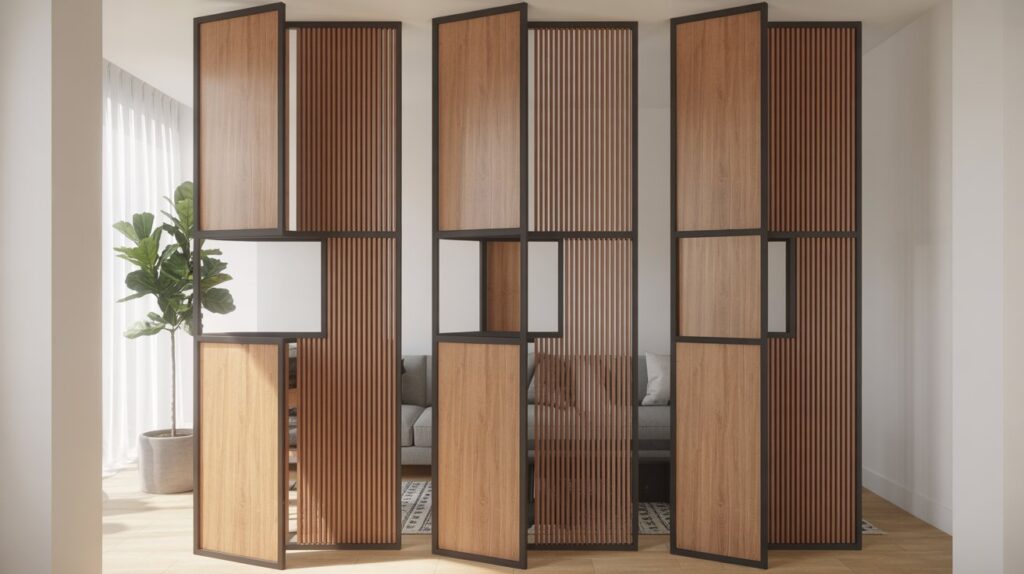
Exploring Customisable Modular Options
Modern modular systems transform spatial division into a design-led process. Brands like B&Q offer clever click-together units in materials ranging from reclaimed wood to powder-coated steel. These partitions slot into place like three-dimensional puzzles, creating tailored configurations for dining nooks or home offices.
The beauty lies in their dual nature – sturdy enough to support trailing plants or lighting fixtures, yet lightweight for easy repositioning. One John Lewis Partners customer notes: “Our oak partition wall took 20 minutes to assemble and looks like it’s always belonged here.” Such systems adapt as your needs evolve, transitioning from nursery dividers to teenage study screens effortlessly.
When selecting materials, consider both aesthetics and practicality. Wooden modules bring warmth to contemporary spaces, while metal frameworks suit industrial schemes. Most require no tools for assembly – simply connect panels vertically or horizontally to craft your perfect layout. As interior architect Tomas Palmer observes: “Modular partitions let spaces breathe while gently guiding how we inhabit them.”
Arranging Your Furniture for Defined Zones
The secret to harmonious open-plan living lies not in new purchases, but in reimagining your current furnishings. A corner sofa turned diagonally becomes a natural boundary between lounging and dining spaces, while open shelving units create visual pauses that guide movement. This approach respects your room’s existing architecture while introducing gentle structure.
Maximising Existing Pieces for Zoning
Start by identifying pieces with dual purposes. An armoire positioned perpendicular to walls offers both storage and spatial definition – style its top with trailing plants or art objects to soften edges. Interior designer Henrietta Spencer advises: “Treat your furniture like chess pieces. Their placement should solve practical challenges while maintaining visual rhythm.”
Group items thoughtfully to craft intimate zones. Pair an armchair with a side table and floor lamp to form a reading nook, using a rug to anchor the arrangement. For continuity, echo colours across areas – navy cushions on your sofa might reappear in dining chair upholstery.
Consider these practical adjustments:
- Angle bookshelves to create alcoves without blocking light
- Use ottomans with hidden storage as movable boundaries
- Position desks behind sofas to separate work zones
The goal isn’t rigid separation, but rather a flowing layout that acknowledges different functions. By curating rather than crowding, you maintain that cherished sense of space while nurturing calm, purposeful areas.
Designing with a Kitchen Island or Peninsula
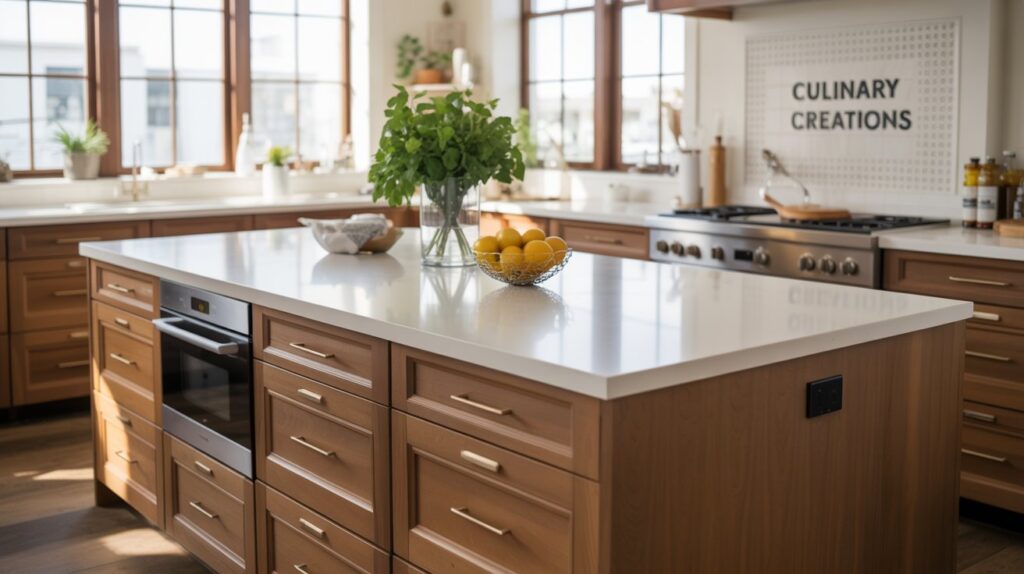
Your kitchen’s layout shapes daily rhythms, and a well-placed island or peninsula becomes its natural anchor. These features effortlessly carve out functional zones while maintaining visual continuity – a balancing act that modern British homes often require. Recent surveys show 63% of UK homeowners prioritise islands for their dual role as workspace and social hub.
Creating Multi-Functional Areas
A thoughtfully designed peninsula acts as both physical boundary and connective element. Imagine kneading dough on one side while guests sip wine across the counter – spatial division without isolation. This setup proves particularly effective in kitchen dining spaces, where meal prep flows naturally into casual conversations.
Consider these practical applications:
- Breakfast bars with pendant lighting define casual eating areas
- Integrated sinks or hobs centralise cooking tasks
- Under-counter storage maximises unused space
Designer Tom Howley notes: “The best islands become family gathering spots – their edges softened by rounded corners and warm materials.” Opt for waterfall quartz worktops that mirror flooring tones, creating harmony between your kitchen and adjacent living areas.
Colour cohesion matters. A navy island in a white home makes a striking yet unifying statement, while reclaimed wood finishes complement rustic schemes. For inspiration on blending styles, explore these cohesive design schemes that translate beautifully to kitchen spaces.
Ultimately, these solutions celebrate adaptability. They grant defined areas for different activities without boxing them in – perfect for homes valuing both function and fluidity. Your kitchen remains the heart of the house, just with smarter rhythm to its beat.
Innovative Room Divider Doors and Panels
Modern interiors demand solutions that adapt as swiftly as lifestyles change. Doors and panels designed for spatial division offer precisely this – combining architectural elegance with everyday flexibility. These elements redefine boundaries while maintaining the fluidity central to contemporary living.
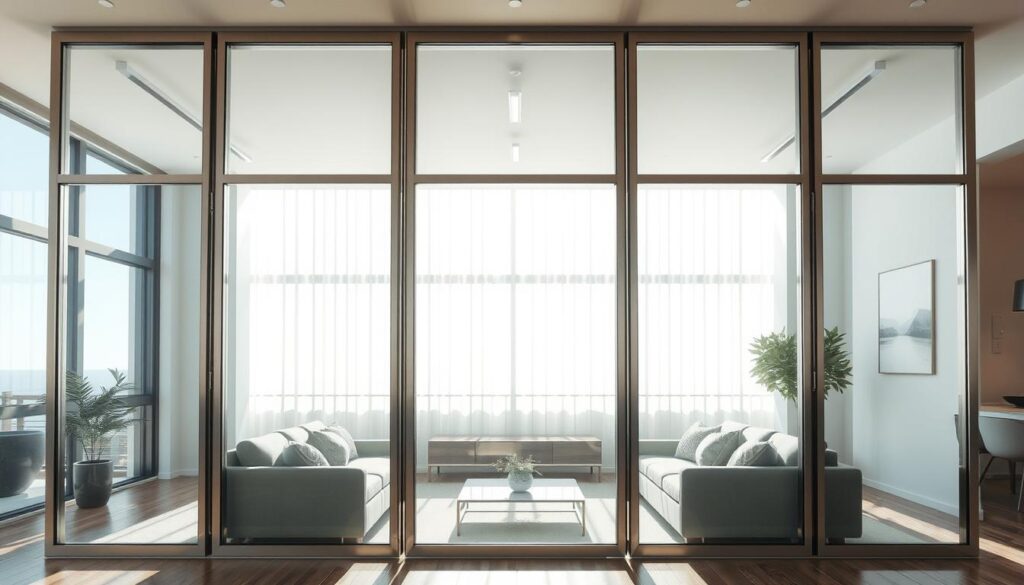
Sliding systems stand out for their space-saving efficiency. Companies like The Sliding Door Company offer frameless glass panels that glide silently, ideal for separating lounge and dining areas. Bifold designs work well in period homes, their concertina motion adding vintage charm. For tighter spaces, pocket doors tuck neatly into walls when not needed.
Frosted or textured glass balances privacy with light diffusion. A Crittall-style steel-framed partition introduces industrial edge while preserving sightlines – perfect for loft conversions. As interior designer Lorna Watson notes: “Glass acts as a visual comma, creating rhythm without full stops between zones.”
When selecting styles, consider:
- Flooring transitions – ensure smooth operation of sliding mechanisms
- Handle designs that complement existing hardware
- Acoustic properties for noise-sensitive areas like home offices
Integrated panels with built-in shelving or planters merge practicality with aesthetics. Brands like B&Q and John Lewis offer modular systems allowing custom configurations. These solutions prove particularly effective in open-plan flats, where distinct areas enhance daily rhythms without compromising on light or style.
How to Divide a Living Room Without Building a Wall
Modern homes thrive on adaptability, and your choice of spatial dividers plays a crucial role. Door systems offer structured separation while preserving your interior’s airy charm – a balance that’s particularly valuable in British households where space often comes at a premium.
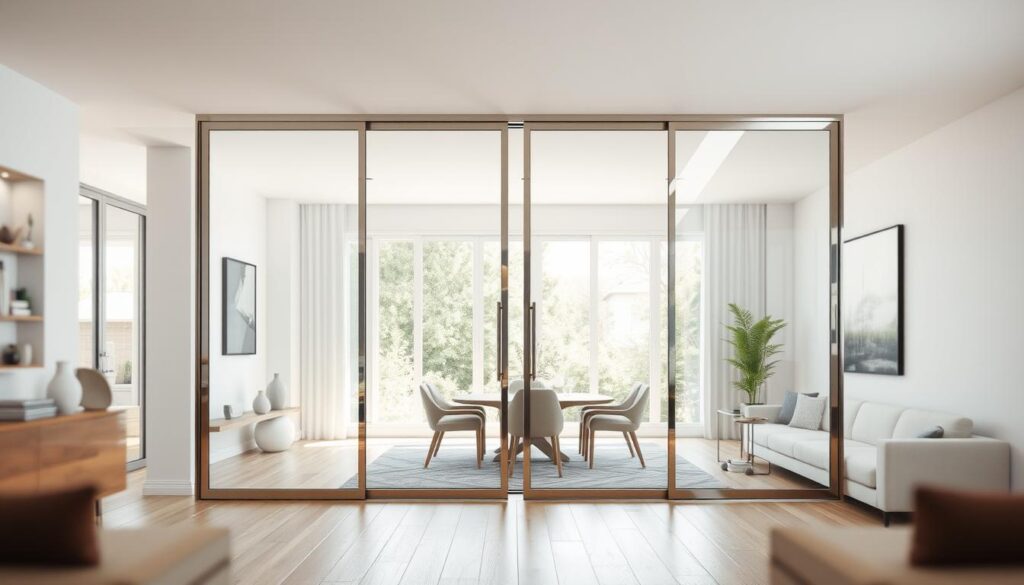
Choosing Between Sliding, Folding and Pocket Doors
Each door type brings distinct advantages to open-plan layouts. Sliding mechanisms excel in tight spaces, gliding effortlessly along tracks without floor obstructions. John Lewis’s aluminium framed designs prove popular for their quiet operation and contemporary aesthetics.
Folding doors create dramatic transformations – concertina-style panels stack neatly when fully opened, perfect for merging living and dining areas during gatherings. For period properties, consider traditional French door styles with modern pivot hinges from suppliers like Arnold Laver.
Pocket doors disappear entirely into walls, offering seamless integration. While installation requires careful planning, their space-saving benefits justify the effort. As architect Emily Kensington notes: “A well-executed pocket door becomes invisible architecture – present only when needed.”
Three key considerations for homeowners:
- Sliding systems need robust overhead tracks for smooth movement
- Folding designs require 10-15cm clearance when fully opened
- Pocket doors demand precise wall cavity measurements
Maintenance proves straightforward with occasional lubrication of tracks and hinges. For DIY enthusiasts, flat-pack kits from B&Q offer cost-effective solutions – though professional fitting ensures longevity in high-use areas.
These door solutions future-proof your space beautifully. Swap frosted glass panels for clear ones as needs change, or repaint wooden frames to match evolving colour schemes. The true magic lies in their ability to redefine rooms without structural commitment – spatial poetry in motion.
Defining Spaces with Rugs, Colours and Lighting
Subtle shifts in texture and tone can orchestrate your space into harmonious zones. A well-placed rug becomes more than décor – it’s a visual anchor that whispers boundaries without shouting separation. Pair this with strategic lighting, and you craft areas that feel distinct yet cohesively designed.
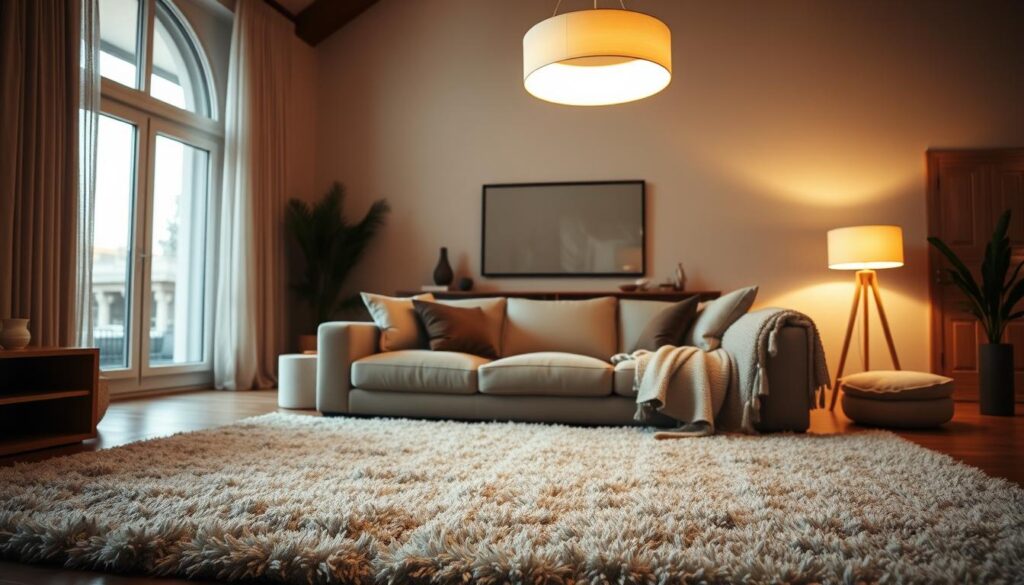
Establishing Boundaries with Colour and Texture
Start by letting your floor guide the eye. Position a large sisal rug beneath your sofa ensemble to ground the lounge area, then contrast with a smaller geometric pattern under dining chairs. This creates natural pause points between functions. Walls can play supporting roles – a soft taupe behind bookshelves transitions gently into warm grey near dining spaces.
Textural contrasts work wonders. A velvet armchair in burnt orange demarcates reading corners, while linen curtains in matching tones maintain flow. As colour consultant Margo Hemming advises: “Treat transitions like sunset gradients – perceptible but never harsh.”
Illumination Techniques for Each Zone
Lighting sculpts spaces as effectively as physical dividers. Hang pendant clusters low over dining tables to create intimate pools of warmth. In lounge areas, position floor lamps behind consoles to cast indirect light upwards, making ceilings feel higher.
Three layered approaches work beautifully:
- Task lighting: Adjustable wall sconces for reading nooks
- Ambient glow: LED strips along shelving to softly define edges
- Accent spots: Directional lights highlighting art between zones
This design philosophy prevents a fragmented feel. By repeating metallic finishes in lamp bases and curtain rods, you create visual threads that weave spaces together. The result? A home that flows effortlessly yet honours each area’s purpose.
Exploring the Versatility of Room Dividing Curtains
Textiles wield quiet power in shaping spaces, offering fluid boundaries that adapt to your day’s rhythm. Curtains excel here, transforming open areas into intimate nooks with a gentle sweep of fabric. Imagine floor-length voile panels creating a sun-dappled home office by morning, then drawn back to unite living areas by evening.
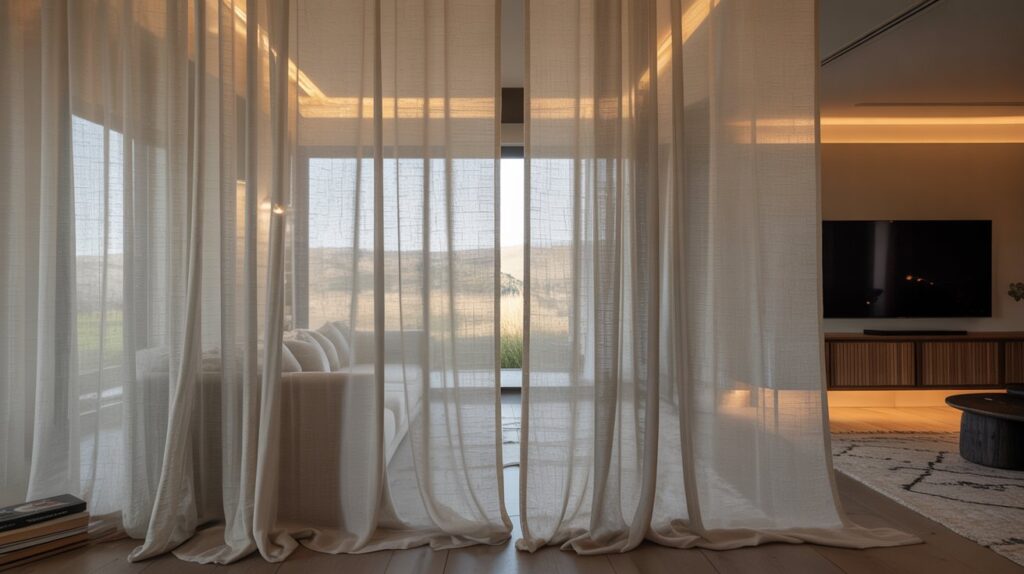
Material choices dictate both function and mood. Sheer linens maintain airiness while diffusing light, ideal for maintaining visual connections between zones. Heavier velvets or jacquard weaves add texture and sound dampening – perfect for separating media spaces from quiet reading corners. As interior stylist Flora Mayfield notes: “The right drape doesn’t shout division – it whispers invitation.”
Installation needn’t involve complex fittings. Ceiling-mounted tracks offer seamless operation, while tension rods provide renter-friendly flexibility. For arched doorways or unusual layouts, curved rails from brands like Silent Gliss ensure smooth movement. Consider layering – pair blackout curtains with translucent overlays for adjustable privacy.
Renters particularly benefit from this approach. Removable adhesive hooks and lightweight fabrics leave no trace on walls, whilst allowing personal expression through pattern and colour. A bold ikat print might energise a studio flat, whereas muted linen harmonises with period features in converted lofts.
Ultimately, these textile solutions respect spatial fluidity. They redefine areas without rigidity, proving particularly valuable in homes where needs shift hourly. Your living space remains united yet thoughtfully composed – a testament to curtains’ quiet transformative power.
DIY Room Divider Ideas for Customisation
Unleash your inner designer with projects that transform overlooked items into bespoke spatial solutions. Repurposing materials not only saves money but lets you craft dividers reflecting your unique aesthetic – a perfect marriage of thrift and creativity.
Start by assessing what you already own. That inherited bookcase gathering dust? Flip it sideways, add castors, and suddenly you’ve got a mobile partition with built-in storage. Style one side with favourite novels, the other with trailing pothos for biophilic charm.
Repurposing Bookshelves, Pallets and More
Wooden pallets offer surprising potential when treated with imagination. Sand rough edges, paint in heritage hues like Farrow & Ball’s Pigeon, then fix fabric panels to create textural interest. For industrial flair, leave sections bare to showcase the raw timber’s character.
Consider these accessible DIY ideas:
- Upcycle bifold doors as artistic screens – stencil botanical patterns or decoupage vintage maps
- Mount salvaged window frames on castors for movable light-filtering partitions
- Transform ladder-style towel racks into vertical plant displays using S-hooks and terracotta pots
Personalisation proves key. A bespoke divider might incorporate family photos in floating frames or favourite fabric swatches. Try this approach: stain wooden slats to match existing furniture, then alternate with copper piping for metallic accents.
As DIY expert Martha Roberts advises: “Treat each project as a conversation between function and self-expression. Your space should whisper your story.” Whether using reclaimed timber from local reclamation yards or experimenting with curtain wire systems from B&Q, the possibilities invite playful experimentation.
Incorporating Decorative Screens and Partitions
Decorative screens and partitions dance between form and function, offering spatial poetry for modern interiors. These design elements serve as sculptural statements while establishing gentle boundaries – a duality that resonates with style-conscious homeowners. Aluminium-framed designs, for instance, bring industrial elegance to contemporary spaces without casting oppressive shadows.
Consider a laser-cut screen with botanical motifs separating lounge and study areas. Its intricate patterns cast dappled light across both zones, creating visual interest while maintaining airflow. Furniture designer Tom Dixon notes: “The best partitions feel like three-dimensional art – you want to touch them as much as look through them.”
Material selection proves crucial. Lightweight aluminium suits minimalist schemes, its slim profile preserving floor space. For traditional homes, ash wood frames with linen inserts harmonise with heritage features. Brands like West Elm offer modular systems that adapt to evolving layouts – stack hexagonal units vertically for dramatic height or arrange horizontally as room-length dividers.
Subtle design details enhance versatility:
- Pebbled glass panels diffuse light in open-plan kitchens
- Powder-coated steel grids support climbing plants in biophilic schemes
- Acoustic felt versions dampen sound between home office and play areas
These solutions excel at spatial choreography. A folding screen with abstract marbling might conceal a cluttered corner by day, then transform into a dinner party backdrop by night. Their true genius lies in balancing discretion with statement-making potential – practical tools that elevate your interior narrative.
Balancing Aesthetics and Function in Room Design
True harmony in living spaces emerges when beauty and purpose hold equal weight. The challenge lies in crafting areas that feel intentional yet effortless – spaces where every element serves your lifestyle while sparking joy. It’s about creating a dialogue between form and function, where storage solutions whisper elegance and seating arrangements sing practicality.
Integrating Style with Practicality
Consider an ottoman that moonlights as blanket storage, or a console table doubling as a desk. These design choices exemplify how multi-use pieces can streamline your home without clutter. Interior experts champion this approach – as designer Natalia Miyar notes: “The most successful rooms are those where you can’t tell where the art stops and the utility begins.”
Continuity matters. A sideboard matching your shelving’s wood tone creates visual flow between zones, while varied textures add depth. Try pairing matte ceramic lamps with velvet cushions in the same colour family – subtle contrasts that feel cohesive.
Flexible and Cost-Effective Solutions
Affordable adaptability shines in repurposed items. That vintage trunk becomes a coffee table with hidden storage, while floating shelves display ceramics and corral remotes. Options like fold-down desks or stackable stools cater to evolving needs without breaking budgets.
Three principles guide successful blends of style and function:
- Choose furnishings with clean lines that complement multiple décor schemes
- Incorporate closed storage to minimise visual noise in busy areas
- Use lighting strategically – directional spots highlight art while providing task illumination
Thoughtful planning transforms challenges into opportunities. By viewing each design decision through dual lenses – beauty and usefulness – you craft a home that feels both curated and comfortably lived-in.
Practical Tips for Creating a Multi-Use Living Space
Crafting a versatile living area requires clever strategies that respect both function and form. Start by viewing every piece as an opportunity – that ottoman isn’t just seating, but hidden storage for throws and board games. Consider how elements can serve dual purposes while maintaining visual harmony.
Smart Solutions for Everyday Needs
Maximise vertical space with floating shelves above sofas or desks. IKEA’s EKET series offers modular units that hold books and display objects without dominating floorspace. For privacy, position a slim etagere bookcase perpendicular to seating areas – style it with trailing plants to soften edges.
Lighting plays a subtle yet powerful role. Angle table lamps towards seating nooks to create intimate pools of light, while leaving walkways softly illuminated. Dunelm’s adjustable floor lamps work beautifully for this layered approach.
Three simple adjustments yield quick results:
- Swap coffee tables for storage trunks with lift-up lids
- Use room dividers with built-in hooks for hanging plants or artwork
- Position rugs at contrasting angles to define separate areas
Even minor changes matter. A console table behind your sofa instantly creates a boundary for dining or workspaces. As interior organiser Marie Newton advises: “Treat your room like a Swiss Army knife – every element should have purpose and polish.”
Don’t fear experimentation. Try shifting your armchair 45 degrees to carve out reading corners, or test different curtain lengths to section off spaces. The goal isn’t perfection, but a layout that adapts as fluidly as your daily life does.
Conclusion
Your living space whispers possibilities through clever spatial choreography. From lush botanical screens to modular partitions, non-permanent solutions let you craft intimate zones while preserving that cherished open-plan feel. These approaches honour natural light and airflow – essentials in British homes where every sunbeam matters.
Consider repurposing existing furniture as dual-purpose room dividers. A well-styled bookcase or angled console table creates subtle separation without construction dust. For renters, removable options like tension-rod curtains or mobile plant stands offer adaptable design freedom.
The true magic lies in balancing practicality with personality. DIY projects transform pallets into rustic partitions, while thrifted screens become canvas for self-expression. As daylight shifts through your space, these thoughtful touches enhance both aesthetics and daily rhythms.
Ultimately, your home deserves solutions that evolve with life’s chapters. Whether using acoustic panels for noise control or pendant lights to define dining nooks, each choice should reflect your story. With creativity as your guide, boundaries become bridges – connecting function and beauty in every carefully curated corner.

